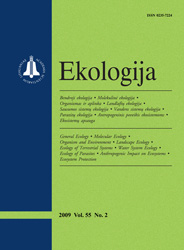 ISSN 0235-7224 ISSN 2029-0586 (online) |
2010 m. Nr. 3-4 Triphasic approach to assessment of bacterial population
in different soil systems
Using more than one approach to the analysis of soil systems has always been a better option than a single approach due to the presence of complex genomes in metagenomic DNA samples. A combined triphasic approach using qPCR, DGGE and SSU ribosomal gene sequencing was applied to analyze the bacterial load on different soil systems (subalpine, temperate, subtropical and tarai) of the Western Indian Himalayas. Temperate soil (Pithoragarh, 80°2’ E, 29°47’ N, 1967 m) showed the maximum copy number (3.97 × 1010/μl of DNA) or concentration (8.56 ± 1.06 ng/μl of DNA) of 16S rRNA gene. DGGE data and cloning of 16S rRNA gene has shown that this soil is most diverse among all the soils analysed in the present study. The lowest ribosomal gene copy number (8.85 × 109/μl of DNA) was observed in subalpine soil (a glacier, 30.44° N, 79° E, 3 133 m). It was concluded from this study that Pithoragarh (a temperate region) soil has a better bacterial load and diversity (among all the soil samples tested) and would be a good option for agricultural practices. Keywords: 16S rRNA, DGGE, qPCR, soil community, the Western Himalayas |
Issues:
2011 - Vol.57 No. 1, No. 2 2010 - Vol.56 No. 1-2, No. 3-4 2009 - Vol.55 No. 1, No. 2, No. 3-4 2008 - Vol.54 No. 1, No. 2, No. 3, No. 4 2007 - Vol.53 No. 1, No. 2, No. 2.priedas, No. 3, No. 4 2006 No. 1, No. 2, No. 3, No. 4 2005 No. 1, No. 2, No. 3, No. 4 2004 No. 1, No. 2, No. 3, No. 4 2003 No. 1, No. 2, No. 3, No. 4 2002 No. 1, No. 2, No. 3, No. 4 2001 No. 1, No. 2, No. 3, No. 4 |